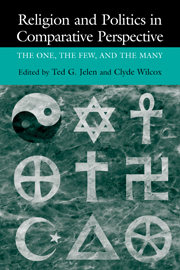Book contents
- Frontmatter
- Contents
- List of Contributors
- Preface
- 1 Religion: The One, the Few, and the Many
- 2 The Challenge of Pluralism
- 3 Catholicism, Politics, and Culture in the Republic of Ireland
- 4 Religion and Politics in Iberia
- 5 The Religious Dimension of Israeli Political Life
- 6 Between Heaven and Earth
- 7 Islamism in Contemporary Arab Politics
- 8 Religion and Politics in a Secular Europe
- 9 Religion and Democracy in South America
- 10 Looking for Hope in Central America
- 11 Religion and Politics in India
- 12 Religion and Politics in Japan
- 13 Religion and Politics in an Open Market
- 14 The Political Roles of Religion
- Index
6 - Between Heaven and Earth
The Dilemma of the Islamic Republic of Iran
Published online by Cambridge University Press: 05 June 2012
- Frontmatter
- Contents
- List of Contributors
- Preface
- 1 Religion: The One, the Few, and the Many
- 2 The Challenge of Pluralism
- 3 Catholicism, Politics, and Culture in the Republic of Ireland
- 4 Religion and Politics in Iberia
- 5 The Religious Dimension of Israeli Political Life
- 6 Between Heaven and Earth
- 7 Islamism in Contemporary Arab Politics
- 8 Religion and Politics in a Secular Europe
- 9 Religion and Democracy in South America
- 10 Looking for Hope in Central America
- 11 Religion and Politics in India
- 12 Religion and Politics in Japan
- 13 Religion and Politics in an Open Market
- 14 The Political Roles of Religion
- Index
Summary
The Iranian revolution of 1979 replaced the monarchial regime of the Pahlavi dynasty with an Islamic republic. The charismatic leader of the revolution, Ayatollah Ruhollah Musavi Khomeini, sought to create a theocratic state to preside over a religiously guided polity. At the helm of this state he envisioned a wise and pious Islamic jurist, the custodian of a true and sacred worldview, leading the faithful and supportive community toward salvation. This vision of a religious polity has been increasingly challenged since Khomeini's death in 1989, and especially since the election of Mohammed Khatami to the presidency. The challenges comes from both without and within the system, and although the most outspoken challengers couched their views in religious terms, their argument denies religion a presiding place in politics, and almost relegates it to the periphery.
There is a struggle underway in Iran that involves competing visions of public life. It involves institutional as well as behavioral, philosophical as well as prosaic, educational as well as judicial realms. The opposing forces have focused most intensely on the constitution of the Islamic republic. The tension that exists between the republican aspects of the constitution and the power given to the religious elite, particularly to the office of the velayat-e faqih (the leadership of the jurisprudent, or supreme leadership), has created the most obvious ground to debate the proper relations between politics and religion.
- Type
- Chapter
- Information
- Religion and Politics in Comparative PerspectiveThe One, The Few, and The Many, pp. 123 - 138Publisher: Cambridge University PressPrint publication year: 2002
- 1
- Cited by



